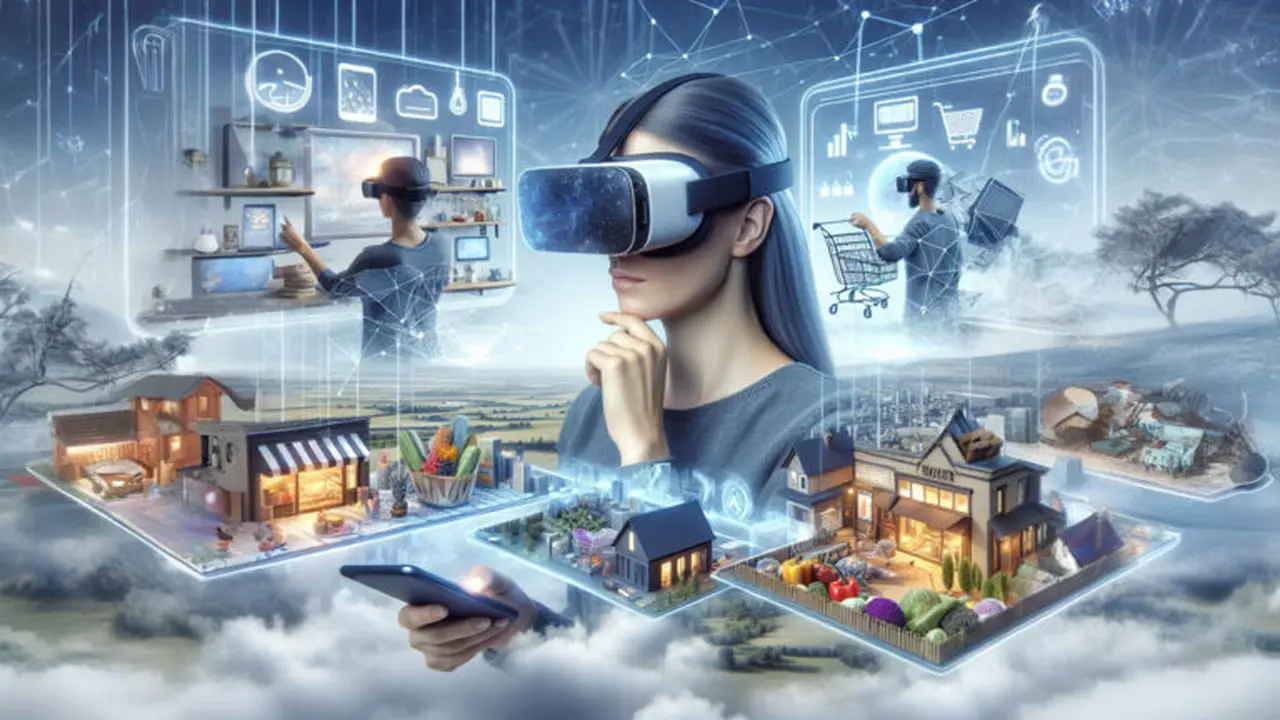Augmented Reality and Virtual Reality in SEA & Mexico E-commerce
Sample meta description.

Introduction: The Immersive Future of Shopping in Southeast Asia and Mexico
Alright, buckle up buttercups, because we're diving headfirst into the wild world of Augmented Reality (AR) and Virtual Reality (VR) in e-commerce, specifically focusing on Southeast Asia (SEA) and Mexico. Forget scrolling through endless product pages – we're talking about *experiencing* products before you even hit that "add to cart" button. This isn't some far-off sci-fi dream; it's happening *now*, and it's poised to completely reshape how we shop in these vibrant, rapidly growing markets.
Why AR and VR are Primed for E-commerce Growth in SEA & Mexico: Market Dynamics and Consumer Behavior
So, why these regions? Think mobile-first. SEA and Mexico boast incredibly high mobile penetration rates. People are glued to their smartphones, and AR/VR experiences are becoming increasingly accessible through these devices. Plus, there's a genuine appetite for innovation and new technologies. Consumers are eager to try out these immersive shopping experiences, especially if they offer tangible benefits like trying on clothes virtually or visualizing furniture in their homes. Add to that the burgeoning middle class with increased disposable income, and you've got a recipe for explosive growth.
AR Applications in E-commerce: Virtual Try-Ons, Product Visualization, and Enhanced Customer Engagement
Let's break down how AR is already making waves. The big one? Virtual Try-Ons. Imagine buying glasses online and being able to see exactly how they look on your face, without ever stepping foot in a store. Or trying on makeup shades from your favorite brand, all from the comfort of your couch. This is a game-changer for reducing returns and increasing customer confidence. Then there's Product Visualization. Thinking about a new sofa? Use AR to see how it fits in your living room, playing with different colors and arrangements. It's like having a personal interior designer in your pocket! Beyond that, AR is enhancing Customer Engagement through interactive product demos, virtual showrooms, and gamified shopping experiences. It's all about making shopping more fun and engaging.
VR Experiences in E-commerce: Virtual Showrooms, Immersive Product Demos, and Brand Storytelling
VR takes things to a whole new level. Forget static product images; VR allows you to step inside a Virtual Showroom. Imagine browsing a car dealership from your living room, inspecting every detail of the vehicle. Or touring a luxury apartment complex without leaving your home. VR also enables incredibly immersive Product Demos. Think about experiencing a new video game before buying it, or getting a hands-on (virtually, of course) demonstration of a complex piece of machinery. And let's not forget Brand Storytelling. VR can transport you to the origin of a product, letting you experience the craftsmanship and passion that goes into its creation. It's about building a deeper connection with the brand.
Specific Product Examples Leveraging AR & VR in SEA & Mexico: Case Studies and Real-World Applications
Okay, enough theory. Let's get real. Here are some specific examples of how brands are using AR and VR to rock the e-commerce world in SEA and Mexico:
- Lazada (SEA): Lazada has been experimenting with AR features that allow customers to virtually "place" furniture and appliances in their homes before buying. This addresses a key pain point for online shoppers, reducing the risk of buying something that doesn't fit or look right.
- Liverpool (Mexico): This department store chain has implemented VR experiences in some of their physical stores, allowing customers to virtually explore different room settings and visualize furniture arrangements. They are exploring bringing this experience online.
- Perfect Corp (Global, with focus on SEA): Their YouCam Makeup app is a global phenomenon, but it's especially popular in SEA. It allows users to virtually try on makeup from various brands, significantly boosting sales and engagement. YouCam also partners with brands to integrate their AR technology directly into their e-commerce platforms.
Augmented Reality Product Recommendations and Comparisons: Try Before You Buy
Let's talk specifics about AR-enabled products. We'll focus on virtual try-on applications in different sectors.
Eyewear: Warby Parker vs. Zenni Optical AR Try-On
Both Warby Parker and Zenni Optical offer AR try-on features for their glasses. Warby Parker: Known for its stylish frames and ease of use. Their AR try-on is integrated seamlessly into their app and website. The experience is generally smooth and accurate. Price range: $95 - $195. Zenni Optical: Offers a wider selection of frames at much lower prices. Their AR try-on is functional, though sometimes less accurate than Warby Parker. Price range: $6.95 - $49.95. Comparison: Warby Parker offers a premium experience with higher-quality frames and a slightly more polished AR implementation. Zenni Optical provides a more budget-friendly option with a vast selection and a decent AR experience. Use Case: Someone looking for trendy, high-quality glasses with a smooth AR experience might prefer Warby Parker. Someone on a tight budget who wants a wide selection would benefit from Zenni Optical.
Makeup: Sephora Virtual Artist vs. Ulta Beauty GLAMlab
These apps allow users to experiment with different makeup looks virtually. Sephora Virtual Artist: Offers a wide range of products from various brands. Their AR technology is generally considered very accurate and provides realistic results. Price varies greatly depending on the product. Ulta Beauty GLAMlab: Focuses on products available at Ulta Beauty. The AR experience is good, but sometimes less refined than Sephora's. Price varies greatly depending on the product. Comparison: Sephora offers a broader selection of brands and a slightly more advanced AR experience. Ulta Beauty focuses on its own product range and provides a solid, if less polished, AR try-on. Use Case: Makeup enthusiasts who want to experiment with a wide range of brands might prefer Sephora. Those who primarily shop at Ulta will find GLAMlab more convenient.
Clothing: ASOS Virtual Catwalk vs. Wannaby Shoes
Clothing and shoe brands are starting to experiment with AR. ASOS Virtual Catwalk: Allows you to see models "walking" in clothes you're considering. This is less about a perfect fit and more about visualization and style. Price varies greatly depending on the clothing. Wannaby Shoes: Focuses specifically on trying on shoes virtually. Their AR technology is surprisingly accurate and allows you to see how the shoes look on your feet in different environments. Price varies greatly depending on the shoe. Comparison: ASOS focuses on broader visualization, while Wannaby specializes in shoe try-ons with impressive accuracy. Use Case: ASOS is great for getting a sense of how clothes move and look on a body. Wannaby is perfect for trying out different shoe styles and colors before buying.
Virtual Reality Product Recommendations and Comparisons: Immersive Shopping Experiences
VR is still relatively nascent in e-commerce, but here are some emerging examples and theoretical comparisons.
Automotive: BMW Virtual Showroom vs. Audi VR Experience
While specific VR implementations vary, both brands are exploring virtual showrooms. BMW Virtual Showroom (Example Conceptualization): Imagine a VR experience where you can configure your dream BMW, explore the interior, and even "take it for a virtual test drive" on different terrains. Price: Not applicable (virtual experience). Cost of the car: Varies widely. Audi VR Experience (Existing Example): Audi already offers some VR experiences in dealerships. A fully realized online VR showroom would allow customers to explore different models, customize features, and learn about the technology in an engaging way. Price: Not applicable (virtual experience). Cost of the car: Varies widely. Comparison: Both aim to provide an immersive and engaging way to explore their vehicles. The key difference would lie in the level of detail, interactivity, and realism. Use Case: Anyone interested in buying a new BMW or Audi would benefit from these VR experiences, especially those who live far from dealerships or want a more personalized and engaging shopping experience.
Real Estate: Matterport VR Tours vs. Zillow 3D Home
These platforms offer virtual tours of properties. Matterport VR Tours: Creates highly realistic and immersive 3D models of properties. Can be viewed on VR headsets for a truly immersive experience. Price: Varies depending on the property and service provider. Zillow 3D Home: Offers a more accessible and user-friendly way to explore properties virtually. Can be viewed on any device without a VR headset. Price: Included in some Zillow listings. Comparison: Matterport offers a higher level of realism and immersion, while Zillow 3D Home is more accessible and convenient. Use Case: Matterport is ideal for showcasing high-end properties or for buyers who want a truly immersive virtual tour. Zillow 3D Home is great for initial property exploration and for buyers who don't have access to VR headsets.
Challenges and Opportunities: Overcoming Barriers to Adoption and Maximizing the Potential of AR/VR in E-commerce
Of course, it's not all sunshine and rainbows. There are challenges. Cost is a big one. Developing high-quality AR/VR experiences can be expensive. Then there's the issue of Accessibility. Not everyone has access to the latest smartphones or VR headsets. And let's not forget the User Experience. Clunky or poorly designed AR/VR experiences can actually deter customers. However, the opportunities are immense. As technology becomes more affordable and accessible, and as user experiences improve, AR/VR will become an increasingly integral part of the e-commerce landscape in SEA and Mexico. Brands that embrace these technologies early will be well-positioned to capture market share and build stronger relationships with their customers.
The Future is Immersive: Predictions for AR/VR in SEA & Mexico E-commerce by 2025
Looking ahead to 2025, expect to see even more sophisticated AR/VR applications in e-commerce. Think AI-powered virtual stylists who can provide personalized recommendations based on your body type and style preferences. Or virtual shopping assistants who can guide you through complex purchases, answering your questions and providing real-time support. We'll also see more seamless integration of AR/VR into the overall shopping journey, from product discovery to checkout. The future of e-commerce is immersive, interactive, and personalized, and AR/VR will be at the heart of it all in SEA and Mexico.
:max_bytes(150000):strip_icc()/277019-baked-pork-chops-with-cream-of-mushroom-soup-DDMFS-beauty-4x3-BG-7505-5762b731cf30447d9cbbbbbf387beafa.jpg)






